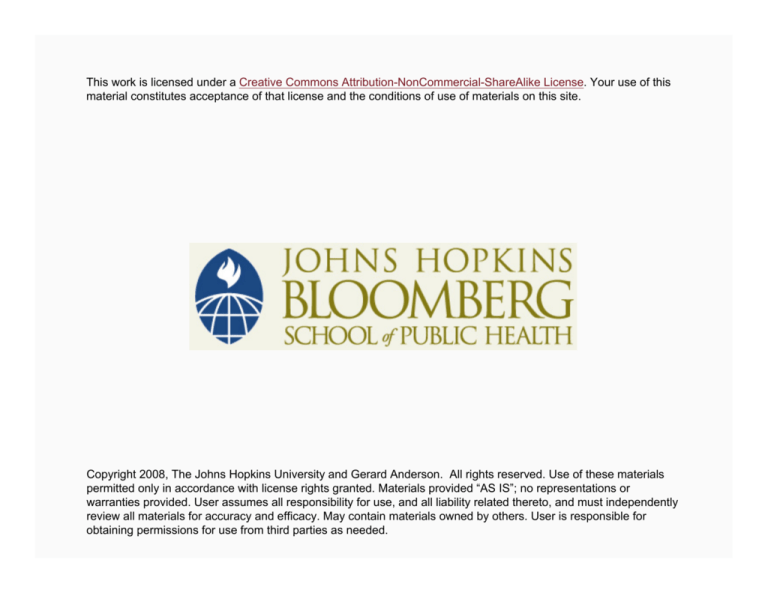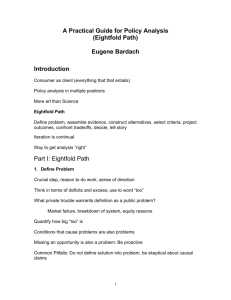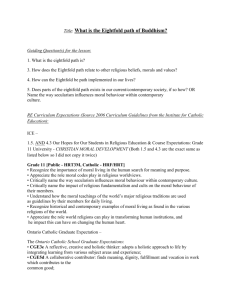
This work is licensed under a Creative Commons Attribution-NonCommercial-ShareAlike License. Your use of this
material constitutes acceptance of that license and the conditions of use of materials on this site.
Copyright 2008, The Johns Hopkins University and Gerard Anderson. All rights reserved. Use of these materials
permitted only in accordance with license rights granted. Materials provided “AS IS”; no representations or
warranties provided. User assumes all responsibility for use, and all liability related thereto, and must independently
review all materials for accuracy and efficacy. May contain materials owned by others. User is responsible for
obtaining permissions for use from third parties as needed.
What Public Health Policy Do YOU Personally Want
to Change?
Gerard F. Anderson, PhD
Johns Hopkins University
Section A
Overview: Interests of the JHSPH Department of Health Policy
My Current Public Health Policy Concerns
People with chronic conditions are being treated by system
designed to provide acute care
Prices for medical services are much higher in the U.S. but
outcomes are not necessarily better
International funding agencies should allocate more
resources towards chronic diseases
Prices paid by the uninsured for hospital care are much
higher than the insured pay
4
My Current Public Health Policy Concerns
People with chronic conditions are being treated by system
designed to provide acute care
Prices for medical services are much higher in the U.S. but
outcomes are not necessarily better
International funding agencies should allocate more
resources towards chronic diseases
Prices paid by the uninsured for hospital care are much
higher than the insured pay
5
Some of the Policy Concerns of Faculty in the HPM Department
Compliance with prevention guidelines
Injury prevention
Public health preparedness
Promotion of physical activity
Gun safety
Health care is available to everyone
Well being of seniors
Eliminating disparities
6
Advocating for Specific Issues
What is the most effective way to advocate for specific issues?
7
Recent Publications
8
Testimony in Congress
9
Talk to Media
10
Policy Development often Requires Analytic Methods
Most faculty in the department have . . .
− One or more areas of policy interest and they use specific
methodological tools to promote/investigate/evaluate
their policy interests
11
My Methodological Tools
Analysis of large datasets
Health care finance/economics
12
Some of the Methodological Tools Taught in HPM
Survey design
Organization and management
Cost effectiveness
Measuring quality of life/quality of care
Health care economics
Ethics
Program evaluation
Policy process
13
Some of the Methodological Tools Taught in HPM
Survey design
Organization and management
Cost effectiveness
Measuring quality of life/quality of care
Health care economics
Ethics
Program evaluation
Policy process
14
Section B
What Do the Policy Leaders Think are the Unaddressed
Concerns in Public Health?
The Future of the Public’s Health in the 21st Century
An Institute of Medicine committee developed 34 specific
recommendations to improve the public’s health
In your opinion, do they address the most important issues?
16
Priority Setting
Which of the 34 recommendations would YOU decide to
tackle first?
17
Advocacy
How would YOU promote the implementation of this
recommendation?
18
Class Overview
Alternative models of policy process
Detailed discussion of rational policy process
Presentations by participants in policy process
Methods used by policy analysts and policy makers
19
Different Models to Understanding the Policy Process
1.
2.
3.
4.
Rational
Garbage can
Incrementalism
Cycle
20
One Example of Rational Policy Process—Eight Fold Path
1.
2.
3.
4.
5.
6.
7.
8.
Define the problem
Assemble some evidence
Construct the alternatives
Select the evaluation criterion
Project the outcomes
Confront the tradeoffs
Decide
Tell your story
21
Analytic Methods Used in Developing Rational Public
Health Policy
Political/legal/ethical
Need/demand
Economic/financial
Assessment/evaluation
22
Grading and Final
Five-page paper concerning the Eight-Fold Path and policy
issue questions
Final exam
− Short questions
− Write an article on an issue in which you are particularly
interested
− See syllabus for more information
23
Section C
Eightfold Path
Policy Process
We are going to assume that the policy process is RATIONAL
25
Other Models of the Policy Process
Incremental approach
Garbage can
26
Eightfold Path
There are many different ways to characterize the RATIONAL
policy process
We will use a formulation by Bardach
Other characterizations are equally valid and may explain
certain policy processes more completely or more accurately
than the Eightfold Path
27
Eightfold Path
Define the problem
Assemble some evidence
Construct the alternatives
Select the evaluation criterion
Project the outcomes
Confront the trade-offs
Decide
Tell your story
28
Define the Problem
What is the specific problem
− Be as concrete as possible
Why are you advocating a specific policy change?
29
1. Define the Problem
Use too little/too much if possible
Quantify if possible
Define the problem, not the remedy
You may need to redefine the problem several times
30
Recommendation 29
Congress should increase funding to Health Resources and
Services Administration (HRSA) programs that provide
support for public health students…
31
What Is the Specific Problem?
Not enough money is spent on public health training
Not enough public health training
Public health professionals are poorly trained
Lack of funding in public health training discourages
interested applicants
Public health students leave school with too much debt
32
Specific Problem
Lack of funding in public health training discourages lowincome applicants
33
2. Assemble Some Evidence
Data—facts
Information—facts with meaning/categories
Evidence—information that alters behavior
34
Purpose of Evidence
Assess nature of problem
Analyze features of specific policy options
Assess the performance of similar policies
35
Value of Evidence
May cause a better decision
Different decision may lead to a better outcome
Evidence suggests how much the situation can be improved
36
Different Approaches to Evidence Collection
Use analogies
Survey “best practice”
Literature review
Collect data
37
Assemble Some Evidence—Public Health Training
Debt of public health students
Debt of public health students vis-á-vis other professional
students
Return on investment in public health education vis-á-vis
other professional students
38
Assemble Some Evidence—Public Health Training
Application rates by income level
39
3. Construct the Alternatives
Policy options
Alternative courses of action
Alternative intervention strategies
40
Approach to Construct the Alternatives
Start comprehensive, but end up focused
Difficult to evaluate more than four alternatives
41
Construct the Alternatives—Public Health Training
Grant program to schools based on need
Grant program to students based on need
Grant program to schools based on ability
Grant program to students based on ability
42
Section D
Eightfold Path II
Eightfold Path
Define the problem
Assemble some evidence
Construct the alternatives
Select the evaluation criterion
Project the outcomes
Confront the trade-offs
Decide
Tell your story
44
4. Select the Criterion
Analytic—what are the consequences?
Evaluative—value judgments about consequences
45
Potential Evaluative Criteria
Efficiency—maximize satisfaction (utility)
Equity—maximize equality, fairness, social justice
Personal freedom—maximize individual choice
Community—maximize solidarity
Legality—is it permitted?
46
Select the Criteria—Public Health Training
Efficiency—lowest administrative cost
Equity—need-based
Personal freedom—greater choice if all schools have funding
Legality—funding rules established by Congress
47
5. Project the Outcomes
Most difficult step
Hard to predict future
Hard to be realistic when an advocate
Hard to be certain about likely outcomes
48
Project the Outcomes—Techniques
Develop analytic model(s)
Develop empirical estimates
Consider alternative scenarios
Consider undesirable side effects
Develop outcomes matrix
49
Project the Outcomes
How many more low-income students will choose public
health as a career with grant programs?
50
6. Confront the Trade-offs
Is one alternative clearly dominant?
− The best choice on all criteria
Eliminate any alternative which is dominated by
another alternative
Which criterion is most important?
51
Confront the Trade-offs: Select the Criteria
Possible criteria to evaluate alternatives
− Efficiency
− Equity
− Personal freedom
− Legality
Assume equity is the most important criterion
52
Analytic
Projections of how each option will increase the number of
low-income applicants
53
Confront the Trade-offs Matrix
HRSA grant program to
schools based on need
HRSA grant program to
students based on need
HRSA grant program to
schools based on ability
HRSA grant program to
students based on ability
Equity
+
++
0
0
54
7. Decide—Public Health Training
Allocate grants to students based on need
55
8. Tell Your Story
Thirty seconds
Who is audience?
What medium to use?
What is the message?
56
Tell Your Story
Audience is Congressional appropriations staff
57
Tell Your Story
More low-income students would enter public health if they
received grants based on need. This would lead to better
health outcomes in low income areas
58








